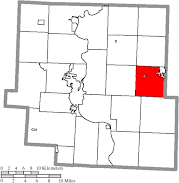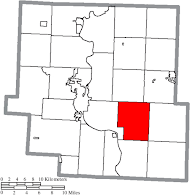Muskingum County Genealogy
Muskingum County, Ohio Family History and Research
Sunday, May 5, 2024
Union Township
Saturday, April 13, 2024
Salt Creek Township
Salt Creek Township is named for the saline deposits near the area that would eventually become the village of Chandlersville. Native Americans gathered salt there long before the appearance of White settlers, and it might have been from them that the settlers in Marietta heard of the salt deposits, for which there was a desperate need. In 1795, Marietta had grown so much, that salt had become a scarce commodity. A company was formed to go north to locate the Salt Creek deposits, "mine" them, and ship much-needed salt back to Marietta and other river towns. It was a lucrative enterprise because everyone needed salt, primarily to preserve food.
 |
John Chandler's grave marker in Chandlersville Cemetery |
Friday, February 2, 2024
Falls Township and Zanesville
In May, 1796, Congress approved a contract with Col. Ebeneezer Zane, a Revolutionary War veteran, to begin construction of a road from Wheeling, Virginia* to Limestown [Maysville], Kentucky. Zane's Trace followed trails originally used by Native Peoples, and although the trails were widened to 20 feet, Zane's Trace was not "paved" in any way, and deep ruts made wagon travel along the route very challenging. It remained the only major road in Ohio until 1823 when construction on the Ohio section of the National Road began. The National Road, known today as US Route 40, followed much of Col. Zane's road.
 |
| Zane's Trace in southern Ohio |
Col. Zane, for whom Zanesville is named, was aided in his road-building project by his brother, Jonathan, and his son-in-law, John McIntire, who arrived in what would become Falls Township in 1798. McIntire, who had been an itinerant cobbler in Virginia, re-made himself as a land developer in Ohio, thanks to his connection to the land-rich Col. Zane. (Zane was paid for his roadwork with tracts of land all along the route.) McIntire called the town he began platting, Westbourne. The Postmaster General changed the name to Zane's Town and that name morphed,eventually, into Zanesville.
While Westbourne-Zane's Town-Zanesville was growing, so was the surrounding rural area. Moses Dillon, a Virginia Quaker, arrived about 1804 (the year the federal government opened a land office in Zanesville) and purchased 3,000 acres of land, including the falls on the Licking River. The land he bought was rich with iron ore, and Dillon established the first blast furnace and foundry west of the Alleghanies by 1805. Not surprisingly, the village which grew up on Dillon's land was known as Dillon's Falls. Four years later, on March 9, 1808, Falls Township was organized.
(1).jpg) |
| Muskingum County Home c. 1900 |
 |
| Smith House |
 |
| Headley Inn |
*West Virginia did not become a state until 1863.
Friday, January 5, 2024
Licking Township
 |
| A stage coach stop in Irville |
Licking Township's two main "population centers" were the villages of Irville, platted in 1814, and Nashport, platted in 1827 to be a "port" along the newly opened Ohio Canal. Pleasant Valley, a third population center, was located on the opposite side of the Licking River from Irville and Nashport. With the founding of Irville came the township's first schoolhouse, and a Presbyterian church which was first frame building in the township. A stagecoach route connecting Columbus and Zanesville ran through the area, and a couple of taverns served tired and thirsty travelers, as well as the locals.
In the 1960s, the construction of Dillon Dam erased Irville, Nashport, and Pleasant Valley, as well as several smaller township communities, off the map. Families were displaced and homes and stores were torn down. Bodies were exhumed from cemeteries and reinterred elsewhere. Some buildings from the original villages were moved to "New" Nashport, the township's only current-day population center.A detailed history of the three lost population centers, can be found in Before Dillon: Memories of the Lost Villages of Nashport, Irville, and Pleasant Valley by Rose Ellen Jenkins and Mari McLean. The book is available for purchase at the MCCOGS Market Place http://mccogs.org/sales.html
Saturday, November 4, 2023
Jefferson and Cass Townships
 |
| Jefferson Township |
 |
| Cass Township |
Undoubtedly hoping to grow the Dresden area, Jefferson Township held a special election in 1852 to issue $100,000 (about $360,000 today) in bonds to the Steubenville & Indiana Railway to construct a rail-line through the village. A literal "town and country" argument ensued between the township's farmers, who didn't want assume the tax liability for the bonds, and the residents of Dresden who did. On September 6, 1853, the disagreement led to the division of Jefferson into two townships, Jefferson (half of which is the village of Dresden) and Cass. The farmers of newly formed Cass Township expected the division would allow them to avoid the taxation resulting from the bonds purchase. It didn't. And to add insult to Jefferson's injury, the railway line ended up being situated one and a half miles north of Dresden, so its residents never saw the hoped-for return on their investment.
Today, Cass township remains almost completely rural with a population in 2020 of 1,811 people. Its only population areas are a small portion of the village of Dresden, and two unincorporated communities, Adams Mills and Trinway. The tiny township of Jefferson has a population of 1,974, with the majority (1,654) living in Dresden.
Friday, March 10, 2023
Springfield Township
Springfield Township was formed from Muskingum County's first township, Newton, on June 21, 1803. Ohio had just been admitted to Statehood on March 1 of that year. However, white settlement had begun along the junction of the Licking and Muskingum Rivers as early as the late 1790's. Col. Ebeneezer Zane directed the creation of a primitive road from Wheeling, West Virginia to Maysville, Kentucky during 1796-1797 to encouragement white settlement in the Northwest Territory and in the new state of Kentucky. The settlement of Westbourne, which was renamed Zanesville, grew up as a waypoint along "Zane's Trace," which is also known as the Maysville Pike. Col. Zane received a land grant of 640 acres in return for building the road. Rufus Putnam, Increase Matthews, and Levi Whipple purchased land across the river from Zanesville in 1801, and laid out the settlement of Springfield, which was renamed Putnam in 1814. The two thriving river settlements drew large numbers of settlers to the area, and growth was rapid.
Some "facts" of Springfield Township's settlement from the Everhart publication, History of Muskingum County are:
- According to the Everhart book, David Stokely was the first white settler to build a cabin in the area that would become Springfield Township (1799). However, a more reliable source (Muskingum County Ohio USA) names Henry Crooks and William McCulloch, who operated ferries across the Muskingum River, as the original settlers.
- The first trustees were Dr. Increase Mathews, John Mathews, David Harvey, and Isaac Zane; other township offices established were overseer of the poor, fence viewer, appraiser of houses, lister of taxable property, supervisor of roads, and constable.
- Dr. Increase Mathews, clearly a jack-of-all-trades, was not only the first physician in the area, he also was the first merchant, and he raised fine-wooled sheep.
- Jacob Reagan was the first blacksmith. In addition to the usual blacksmithing work, Reagan did a brisk business making cowbells and horsebells, that enabled settlers to track their livestock when they wandered off into the woods.
- The only newspaper ever published in the township itself was The Methodist Recorder. Is part of its name preserved in the name of the current-day Times Recorder?
- The first Methodist congregation was organized in 1827, and the first church building in the township was erected in 1835
- A lot of horse-thieving apparently happened in the township: The Springfield Association for the Recovery of Stolen Horses was organized in 1833.
 |
| Ferry boat about 1800 |
Saturday, February 18, 2023
Newton, Muskingum County's First Township
Much of what we know--or think we know--today about Newton's (and all other townships') early history comes from History of Muskingum County, Ohio, published by J. F. Everhart & Co. in 1882, and Biographical and Historical Memoirs of Muskingum County, Ohio, published by The Goodspeed Publishing Co., in 1892. While there are nuggets of real history to be found in both books, there is also fictionalized "history." County histories became very popular in the late 19th century, and local families would "subscribe" in order to get their family's name and story into a book. Wanting to portray themselves and their ancestors as pillars of the community, some family members couldn't resist embellishing the facts--or just plain making them up. So if you consult these and other books of this period to find out about your family, don't take everything you read at face value.
 |
| Gladstone grist mill, White Cottage |
- Jacob Smith from Loudoun County, Virginia was the first known white settler to buy land (1797) and build a cabin (1802).
- The first townships trustees were Benjamin Redman, John Beckwith, and Andrew Crooks.
- Andrew Crooks built the first tavern in 1804, before the first road had been cut in the township (1805); he also provided land for the first schoolhouse as early as 1800.
- Between 1802-1812, a number of mills sprang up along Jonathan's Creek, the major stream that ran through the township from southeast to northwest: Moses Plummer built the first grist mill and a sawmill; John Lenhart and Anthony Mauk established the first whiskey mill.
- The first cemetery (now defunct) was located on land belonging to Benjamin Croy: Peter Fauley was the first burial (1815)
- New Milford [Roseville] was laid out by Ezekiel Rose in 1812.*
- Uniontown [Fultonham] was laid out by John Porter and Henry Hummell around 1813. (East Fultonham came into being some years later with the advent of the railroad.)
- Newtonville [White Cottage] took root around 1815.
- Methodist Church circuit riders served the township prior to the organizing of permanent churches; Goshen Methodist Church near Roseville and Uniontown Methodist church were organized around 1830. No church buildings of any denomination were erected in the township
before 1835.
This crockery piece sold for a modest
$175, but one Rambo Pottery piece
recently went for more than $8000 - Because of the quality of the clay soil in Newton, pottery-making became an important local industry from the township's early days. Almost all of the many potteries were "bluebird potteries", family-owned and operated. (See the blog post Potters Here, There, and Everywhere) A few of the local potters, like Joseph Rambo, became very well-known, and today wares bearing Rambo's signature bring very high prices at auction.










